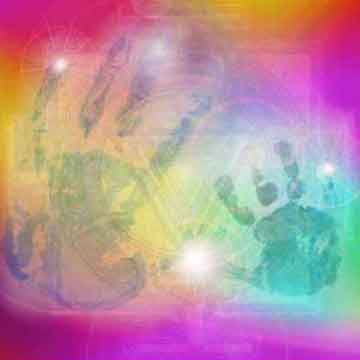

by James Cowan & Colin Beard
Page 91 -
Men like Woodley or Banjo often speak of sacred events occurring in the landscape that are both the physical reflection of that landscape, while at the same time being, in their essential reality, a visionary event. They know that sacred events are of a supernatural order and in no way interfere with what occurs within the realm of ordinary experience. I have never known, for example, an Aborigine to describe in detail what the Rainbow Snake looks like, or indeed Mangela's facial features, because they know that Sky Heroes inhabit a visionary realm and so have no substantial body of their own.
Visionary geography, therefore, borrows from the visible world in order to invoke the subtle realms of the Spirit. It is a metaphysical gift that most traditional (or oral) cultures possess. Literate cultures, such as our own, have more or less lost this gift in their pursuit of documentary evidence. When we think literally we tend to exclude the possibility of the visionary encounter as Aborigines know it. A place - any place - is defined by what we know about it in a factual sense. This precludes subtle knowledge as Aborigines might understand it because such knowledge cannot be defined factually. From an Aboriginal viewpoint, literate peoples have a narrow range of perception when it comes to observing a landscape. Such people see it only in terms of its material potentiality, not in terms of its mystical presence.
Among the domes and gorges of Boonuloolu (the Bungle Bungles) I had been made slowly aware of the extraordinary power of landscape. In Cathedral Gorge I was reminded of Emmanuel Swedenborg's statement: "Man cannot so much as take a step with his feet independently of the influx of heaven". In other words, we are forever walking in the footsteps of gods. In Aboriginal terminology, this would mean that the lingering presence of the Sky heroes forever pervades the world about us.
We spent several days exploring the region. I often tramped up the dry river-bed, skirting rockholes, towering ants' nests and lovely rookeries streaked with birds' dung. On one trek among the domes I found myself powerfully affected by their symmetry. Their honeyed, breast-like appearance encouraged me to experience exhilaration, indeed well-being, in the presence of what is clearly a speechless conglomerate. Or is it?
The truth is, such remote places whose appearance suggests all the vigour of nature's erosive action are, in a way, alive. They are not dead, nor are they the bones of some geological age long since past. What I was walking on and through seethed with terranean existence, as if the earth lived a life of its own, independent of me. Such a life, although it does not partake of normal organic processes like breathing or ingestion, nevertheless requires nourishment if it is to survive. This nourishment is none other than silence. True wilderness draws its strength from the absence of discordant sound. Silence is actually produced in remote gorges, on plains and in mountain valleys to the point where one could liken the process to that of photosynthesis in leaves. Not only is silence important to renewal in nature, its healing power extends to us as well. The silence wilderness produces is as necessary to our well-being and to our spiritual health as the clean air produced by the forests.
Without a living Aboriginal presence, Boonuloolu remained somewhat empty for us. There was no rock art in the chasms to indicate that these places might have been used in ritual observance. I suspected they had not, if only because many of the chasms would have been inaccessible except to an intrepid few. Nor had we been able to discover any stories that might account for the beehives emergence from the plain at the time of the dreaming. Such events are lost. The sanctity of place at Boonuloolu must now remain in the hands of those who willingly embrace the idea of visionary geography as an intermediary. Only by walking up those lonely watercourses between the domes, by ascending the shadow-filled gorges and gazing in wonder at the mosaic of interior images on rock and cliff-face, can one begin to feel the special power, the djang, that permeates this terrain. The Aborigines may have all but abandoned Boonuloolu as a sacred place, but as a national park it may yet continue to enthral visitors when they enter its age-old sacred precinct.
Leaving Boonuloolu was like leaving a ruined church. Each stone behind us represented the silent endeavour of past generations of Aborigines to fathom the mystery of existence. It would take a supreme archaeologist to decipher their message from these domes. Yet I felt it was important to acknowledge them as nature's Rosetta Stone, waiting for an inspired translator who might take up the challenge to unravel their secrets for the benefit of all.
I may add more to these excerpts if & when ...
Okay, here's a bit more ... not sure what page number it is, since all I have in front of me at the moment is the photocopy ... :)
The Spirit in the guise of Rainbow Snake, the Lightning Brothers, Mangela, the Maletji Law Dogs or Warlu are but visible forms to which Aboriginal people are able to cling just as we might cling to the forms inherent in our own religious belief. Nor do these forms inhabit any region of logic or rational understanding as we might know it. They simply exist as symbolic images, on rock-faces deep in caves throughout the country, the ochred paradigms of supernatural existence which defy all our attempts to define them.
More than anything I now recognised how important the story is to the realisation of belief. Aborigines are steeped in oral culture. They rely on the spoken word even more than they do on their rock paintings. Only in the story are they able to transcend everyday existence and enter the timeless realm of the Dreaming. Narrative gives them freedom - the freedom to explore in their hearts and minds those luminosities embedded in the Dreaming itself. By investing their lives with all the trappings of narrative, they are able to give a spiritual dimension to experience, which in turn helps to transform their often harsh material conditions into an acceptable environment for living. They love their country because it is inseparable from the spirit-world of the Dreaming. Since the land was made by Sky Heroes, their individual footfalls echo the primeval sounds of sacred events as they occurred in the Dreaming whenever they perform their ceremonies. Through narrative, they are able to explore all that their hearts yearn for by way of participation in other-worldly existence.
Some Links:

Ancient Art including the Wondjina
Speaking of Wondjina (or Wanjina) paintings ...
This page is worth a gander as well ...
Another excellent page of images
Anthill sculptures - the one in the book was described as being like a 'Giacometti sculpture of the Madonna'
Ken Duncan's shots of Oz, includes the Bungles & some other nice spots
Nice places to bushwalk as well ...
A couple of days later I browsed this book in the shop at the Melbourne Museum ...
Extensive bibliography from a great site called 'Sacred Sites' :)
Dadirri also has some nice links in it, if I recall ...
Whilst adding a few links to that Dadirri page ... found this very 'interesting' page about the WTC ...
click ... well, I suppose if you SCROLL down about nine tenths down the page there IS an image of the lightning brothers from that book I was persuing just yesterday ... :)
Other links from the same day ...
Some interesting webcasts - hopefully still valid links ...
Interesting pamphlet I picked up while I was at the library ...
Some faces I drew recently
{Or click here}
More about Aboriginal beliefs ...
{assuming I remember 2 scan it & upload it ... from Myree Morsi ...}
